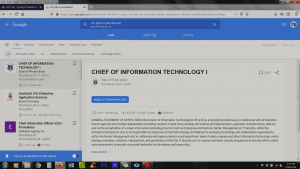If you’re looking for a job, chances are you’ve posted your resume on websites like Monster. We here at Spring Forward Resumes always recommend networking first (that’s how 85% of jobs are found), but effective job search techniques consist of a comprehensive strategy. While Monster is well-known (40,000 resumes are uploaded each day, per Career Directors International), one new, yet highly familiar juggernaut is about to kill all the other job search engines: Google.
“Wait a minute, ” we bet you’re saying. “If I Google what job I’m looking for, won’t it just give me a list of career sites? That’s not a new way to conduct a job search.”
That was true until June 20, 2017, when Google introduced its own job search engine, which populates automatically from the search box. About six months later, it added capabilities for job seekers to learn salary information, sort jobs by location, and have the option to receive job alerts – all in one central place, and from the most-used web search engine (Google accounts for about 75% of web search traffic). If you’re seeking new techniques for an effective job search, this is huge.
Conducting a Job Search Using Google
You can search on Google for all industries and positions, from entry level to executive. For example, let’s say you’re a CIO looking for a job in the Providence, Rhode Island area. You’d enter that into Google:
That leads to a list of all jobs corresponding to that search.
From there, click on the blue “Jobs” tab to get more information on each job.
That brings you into the Google job search engine itself. In the above example, we clicked on the first job, which brought up the job description and other information. You can scroll through all the jobs and even apply directly by clicking on the buttons shown in the job ad.
Another great thing about this search engine is that it culls jobs from all across the web. Experiment with sorting by title, location, date posted, type, company type, and more. You can change the fields at the top to be as specific or general as you want. No more going to this or that site to see who has what listed. In fact, if you want to get notifications on a job search, you can choose to have Google send them directly to your Gmail. Keeping track of online searches and getting emails about fresh new jobs are among the most effective job search techniques.
Google vs. Indeed
One could argue that what Google is doing is what Indeed, another popular search engine that populates with jobs from across the web, is already doing. However, with its power in web search, Google is betting that users won’t have the need – or desire – to go to a separate site looking for jobs. Here’s what Ontame.io, a recruiting analytics platform, has to say on the subject:
“A clever strategy: If Google is to become the first point of contact for job seekers, the company will build up immense power, since its algorithm determines the visibility and eventually the success of the different portals. Indeed fights this attack on its dominating position in the recruitment market by not indexing its exact listing URLs and consequently preventing Google search to show them.”
As technology advances, effective job search techniques are changing fast, and new players are disrupting the recruiting industry. Time will tell how popular the new Google job search engine is, and where Indeed and other career sites ultimately end up, but if history is any indicator, Google will continue to dominate, and technology will continue to disrupt the job search process.

